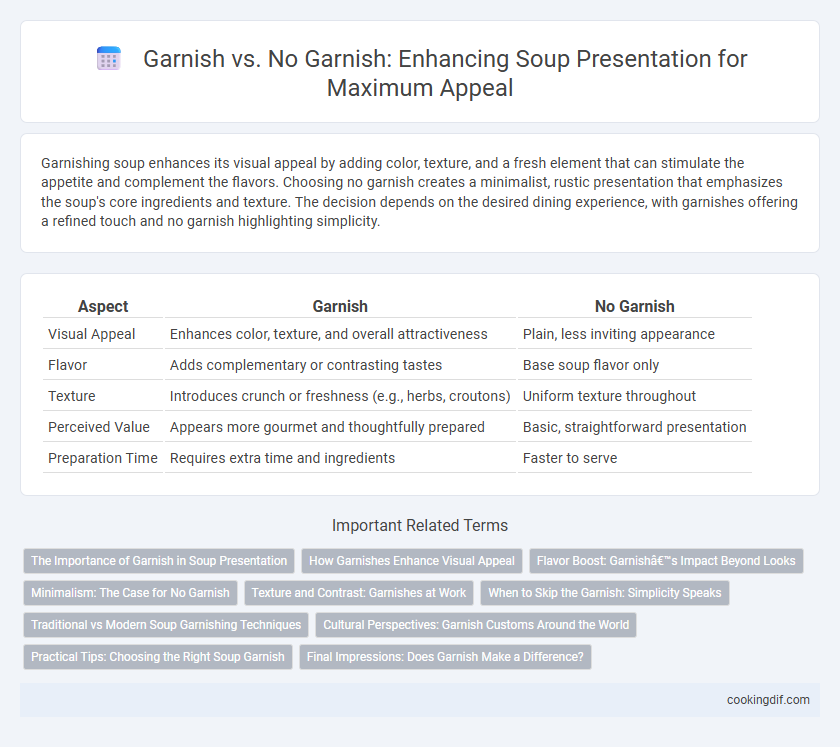Garnishing soup enhances its visual appeal by adding color, texture, and a fresh element that can stimulate the appetite and complement the flavors. Choosing no garnish creates a minimalist, rustic presentation that emphasizes the soup's core ingredients and texture. The decision depends on the desired dining experience, with garnishes offering a refined touch and no garnish highlighting simplicity.
Table of Comparison
| Aspect | Garnish | No Garnish |
|---|---|---|
| Visual Appeal | Enhances color, texture, and overall attractiveness | Plain, less inviting appearance |
| Flavor | Adds complementary or contrasting tastes | Base soup flavor only |
| Texture | Introduces crunch or freshness (e.g., herbs, croutons) | Uniform texture throughout |
| Perceived Value | Appears more gourmet and thoughtfully prepared | Basic, straightforward presentation |
| Preparation Time | Requires extra time and ingredients | Faster to serve |
The Importance of Garnish in Soup Presentation
Garnish plays a crucial role in soup presentation by enhancing visual appeal and signaling flavor profiles to diners. Fresh herbs, a drizzle of cream, or a sprinkle of spices elevate the sensory experience and create contrast in color and texture. Skipping garnish may lead to a less engaging dish that misses an opportunity to highlight key ingredients and refine the overall aesthetic.
How Garnishes Enhance Visual Appeal
Garnishes enhance the visual appeal of soup by adding vibrant colors and contrasting textures that stimulate the appetite. Fresh herbs, spices, or a drizzle of cream create focal points that elevate the overall presentation and suggest flavor complexity. Without garnish, soup can appear plain and less inviting, potentially diminishing the dining experience before the first taste.
Flavor Boost: Garnish’s Impact Beyond Looks
Garnishes enhance soup flavor by adding fresh herbs, spices, or zest that elevate aroma and taste complexity, creating a more vibrant dining experience. Without garnish, soups risk a flat or one-dimensional flavor profile, lacking the bright, contrasting notes that garnishes provide. Incorporating elements like chopped cilantro, a drizzle of infused oil, or a sprinkle of toasted seeds intensifies depth and invites a more engaging palate.
Minimalism: The Case for No Garnish
Minimalist soup presentation emphasizes purity of flavor and visual simplicity by omitting garnishes that can distract from the core ingredients. Serving soup without garnish highlights the natural textures and colors, fostering an elegant and uncluttered aesthetic that appeals to modern culinary trends. This approach enhances the sensory experience by focusing solely on the soup's essence, promoting a refined and intentional dining encounter.
Texture and Contrast: Garnishes at Work
Garnishing soup introduces an essential textural contrast that elevates the overall sensory experience, offering crispness, creaminess, or crunch to complement the soup's primary texture. Without garnish, soups can feel one-dimensional or overly uniform, potentially diminishing visual appeal and flavor complexity. Strategic use of garnishes like herbs, nuts, or a swirl of cream enhances both presentation and mouthfeel, making each spoonful more dynamic and inviting.
When to Skip the Garnish: Simplicity Speaks
Skipping garnish on soup enhances the presentation's minimalist appeal, allowing the natural colors and textures to stand out more prominently. Clear or broth-based soups often benefit from this approach, as added toppings can clutter the visual simplicity and distract from the pure flavor profile. When the soup features vibrant ingredients or delicate aromas, maintaining a clean bowl emphasizes elegance and lets the dish's core qualities shine.
Traditional vs Modern Soup Garnishing Techniques
Traditional soup garnishing techniques emphasize simplicity and natural ingredients like fresh herbs, cream swirls, or finely chopped vegetables to enhance flavor and visual appeal without overpowering the soup. Modern soup presentation often incorporates artistic elements such as edible flowers, microgreens, and intricate foam designs to create a visually striking and gourmet experience. Choosing to garnish or not can significantly influence the perceived quality and dining experience, with traditional methods favoring subtlety and modern approaches highlighting creativity and innovation.
Cultural Perspectives: Garnish Customs Around the World
Garnishing soup varies significantly across cultures, reflecting local customs and culinary traditions that emphasize visual appeal and symbolism. In Japanese cuisine, delicate garnishes like finely sliced scallions or edible flowers enhance both flavor and presentation, while in Middle Eastern cultures, a sprinkle of herbs such as parsley or a drizzle of olive oil adds vibrant color and cultural significance. Contrastingly, some Nordic countries prefer minimalist presentations without garnish to highlight the soup's pure, natural ingredients, demonstrating diverse cultural values in soup aesthetics.
Practical Tips: Choosing the Right Soup Garnish
Choosing the right soup garnish enhances flavor and visual appeal while complementing the soup's texture and ingredients. Fresh herbs like parsley or chives add vibrant color and subtle aroma without overpowering delicate broths, whereas creamy garnishes such as sour cream or yogurt enrich heartier soups. For practical presentation, consider portion size and placement to maintain balance and avoid overwhelming the dish's primary taste profile.
Final Impressions: Does Garnish Make a Difference?
Garnishing soup enhances visual appeal and suggests freshness, often elevating the dining experience through vibrant color and texture contrasts. Soups without garnish may appear plain or less enticing, potentially diminishing the perceived flavor complexity and care in preparation. Ultimately, a well-chosen garnish like fresh herbs or a swirl of cream can significantly impact final impressions by signaling attention to detail and culinary refinement.
Garnish vs No Garnish for presentation Infographic

 cookingdif.com
cookingdif.com